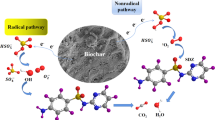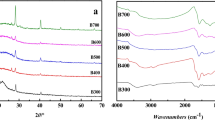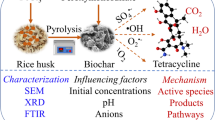Abstract
Rice husk biochar (RHB-2) was prepared from agricultural waste rice husk by high-temperature pyrolysis and modified with NaOH. The char structure before and after modification was characterized by FT-IR, XRD, SEM, and XPS techniques. The effects of different parameters (initial pH of the solution, biochar dosing, persulfate concentration, reaction temperature, and inorganic anions in the solution) on the degradation of ceftazidime were investigated. There is a preliminary examination of the kinetics and reaction mechanism of the alkali-modified rice husk biochar-activated persulfate (PS) for the degradation of ceftazidime. The results indicated that removing ceftazidime by RHB-2/PS is significantly higher than single RHB-2, PS, and RHB-1/PS systems. Under the conditions of biochar dosage of 3 g/L, persulfate concentration of 10 mmol/L, reaction temperature of 60 °C, and no adjustment of initial solution pH, the removal of ceftazidime by RHB-2/PS system reached 95.2% in 80 min. Additionally, the degradation rate could reach 46.67% after the rice husk biochar has been recycled four times, which indicated that rice husk biochar has good reusability and stability. Ceftazidime degradation in the RHB-2/PS system was according to the first-order reaction kinetic model and the identification of radical species demonstrated that the dominant radical for ceftazidime degradation is the sulfate radical.
Graphical Abstract
This study focuses on the use of agricultural waste rice husk as a raw material, using alkali modification technology and the high activation catalytic material prepared by calcination at high temperature, in synergy with the efficient removal of the target pollutant ceftazidime by persulfate. Optimum conditions: 3 g/L catalyst, 10 mmol/L persulfate concentration, 60 °C reaction temperature, no change in pH of the initial solution, 95.2% degradation of ceftazidime in 80 min















Similar content being viewed by others
References
Avramiotis, E., et al. (2021). Oxidation of sulfamethoxazole by rice husk biochar-activated persulfate. Catalysts, 11(7), 850.
Bruce, G. M., Pleus, R. C., & Snyder, S. A. (2010). Toxicological relevance of pharmaceuticals in drinking water. Environmental Science & Technology, 44(14), 5619–5626.
Choi, S., Sim, W., Jang, D., et al. (2020). Antibiotics in coastal aquaculture waters: Occurrence and elimination efficiency in oxidative water treatment processes. Journal of Hazardous Materials, 396, 122585.
Gorito, A. M., Ribeiro, A. R. L., Rodrigues, P., et al. (2022). Antibiotics removal from aquaculture effluents by ozonation: chemical and toxicity descriptors. Water Research, 218, 118497.
Gothwal, R., & Shashidhar, T. (2015). Antibiotic pollution in the environment: a review. Clean-Soil, Air, Water, 43(4), 479–489.
Hiller, A. C. X., et al. (2019). Antibiotic microbial resistance (AMR) removal efficiencies by conventional and advanced wastewater treatment processes: A review. Science of The Total Environment, 685, 596–608.
Huang, H., et al. (2021). Efficient activation of persulfate by a magnetic recyclable rape straw biochar catalyst for the degradation of tetracycline hydrochloride in water. Science of The Total Environment, 758, 143957.
Kern, M., Kulj, S., & Roman, M. (2022). Adsorption of a wide variety of antibiotics on graphene-based nanomaterials: A modeling study. Chemosphere, 296, 134010.
Li, H., & Liu, N. (2023). Application of FeS-activated persulfate oxidation system for the degradation of tetracycline in aqueous solution. Environmental Science and Pollution Research, 30(4), 10745–10755.
Lv, C., et al. (2020). Tetracycline removal by activating persulfate with diatomite loading of Fe and Ce. Molecules, 25(23), 5531.
Ma, H., et al. (2023). Fabrication and detection of a novel hybrid conductive scaffold based on alginate/gelatin/carboxylated carbon nanotubes (Alg/Gel/mMWCNTs) for neural tissue engineering. Tissue & cell, 80, 101995.
Miao, D., et al. (2020). Activation of persulfate and removal of ethyl-parathion from soil: Effect of microwave irradiation. Chemosphere, 253, 126679.
Pei, X., et al. (2021). N-doped biochar from sewage sludge for catalytic peroxydisulfate activation toward sulfadiazine: Efficiency, mechanism, and stability. Journal of Hazardous Materials, 419(4), 126446.
Qiu, Y., et al. (2020). Degradation of anthraquinone dye reactive blue 19 using persulfate activated with Fe/Mn modified biochar: Radical/non-radical mechanisms and fixed-bed reactor study. Science of The Total Environment, 758, 143584.
Ren, W., Xu, G., & Li, D. (2022). Research progress on contamination status, transmission and treatment technology of antibiotics in water environment. Meteorological and Environmental Research, 13(1), 79–83.
Song, J., et al. (2023). Study on persulfate activated by Ce-modified tea waste biochar to degrade tetracycline. Environmental Science and Pollution Research, 30(17), 49632–49643.
Sun, S., et al. (2020). Enhanced degradation of sulfamethoxazole (SMX) in toilet wastewater by photo-Fenton reactive membrane filtration. Nanomaterials, 10(1), 180.
Tang, Y. Q., Ye, Q., & Zheng, W. Y. (2019). Research status and development of antibiotics. World Notes Antibiotic, 40, 295–301.
Tang, Y., et al. (2022). Removal of emerging contaminants (bisphenol A and antibiotics) from kitchen wastewater by alkali-modified biochar. Science of The Total Environment, 805, 150158.
Vieslet, J. P. (2019). Process for converting a biomass into at least one biochar. U.S. Patent 10,428,288, 10-1-2019.
Wang, J., & Zhuan, R. (2019). Degradation of antibiotics by advanced oxidation processes: An overview. Science of The Total Environment, 701(10), 135023.
Wang, B., & Wang, Y. (2022). A comprehensive review on persulfate activation treatment of wastewater. Science of The Total Environment, 831, 154906.
Wang, Q., et al. (2021). Peroxymonosulfate activation by tea residue biochar loaded with Fe3O4 for the degradation of tetracycline hydrochloride: Performance and reaction mechanism. RSC Advances, 11(30), 18525–18538.
Xiong, Q., et al. (2021). Microalgae-based technology for antibiotics removal: From mechanisms to the application of innovational hybrid systems. Environment International, 155, 106594.
Yang, S., He, L., Peng, P., et al. (2022). Synergistic Fe2+/UV activated peroxydisulfate as an efficient method for the degradation of thiacloprid. Process Safety and Environmental Protection, 161, 466–475.
Yao, P., et al. (2018). A study on the preparation of pitch-based high-strength columnar activated carbon and mechanism of phenol adsorption from aqueous solution. RSC Advances, 8(31), 17558–17568.
Ying, S., et al. (2018). Structural and functional alterations in the microbial community and immunological consequences in a mouse model of antibiotic-induced dysbiosis. Frontiers in Microbiology, 9, 1948.
Yu, H. Q., et al. (2018). Sludge biochar-based catalyst for improved pollutant degradation by activating peroxymonosulfate. Journal of Materials Chemistry A, 10(1039), C8TA02282H.
Zhang, K., Sun, P., & Zhang, Y. (2019). Decontamination of Cr (VI) facilitated formation of persistent free radicals on rice husk derived biochar. Frontiers of Environmental Science & Engineering, 13, 1–9.
Zhang, Y., et al. (2021). Heterogeneous activation of persulfate by carbon nanofiber supported Fe3O4@carbon composites for efficient ibuprofen degradation. Journal of Hazardous Materials, 401, 123428.
Zhang, S., et al. (2022). Enhanced removal of tetracycline via advanced oxidation of sodium persulfate and biochar adsorption. Environmental Science and Pollution Research, 29(48), 72556–72567.
Zhao, X. L., et al. (2021). Effects of environmental norfloxacin concentrations on the intestinal health and function of juvenile common carp and potential risk to humans. Environmental Pollution, 287, 117612.
Funding
This study was supported by a grant from the National Natural Science Foundation of China (81273079), the Natural Science Foundation of Heilongjiang Province (E200818), and the State Key Laboratory of Urban Water Resources and Water Environment of Harbin Institute of Technology (ES201918).
Author information
Authors and Affiliations
Corresponding author
Ethics declarations
Competing Interests
The authors have no relevant financial or non-financial interests to disclose.
Additional information
Publisher’s Note
Springer Nature remains neutral with regard to jurisdictional claims in published maps and institutional affiliations.
Rights and permissions
Springer Nature or its licensor (e.g. a society or other partner) holds exclusive rights to this article under a publishing agreement with the author(s) or other rightsholder(s); author self-archiving of the accepted manuscript version of this article is solely governed by the terms of such publishing agreement and applicable law.
About this article
Cite this article
Yang, W., Wang, Gx. & Chen, Jn. Oxidation of Ceftazidime by Modified Rice Husk Biochar-Activated Persulfate. Water Air Soil Pollut 234, 741 (2023). https://doi.org/10.1007/s11270-023-06760-4
Received:
Accepted:
Published:
DOI: https://doi.org/10.1007/s11270-023-06760-4




